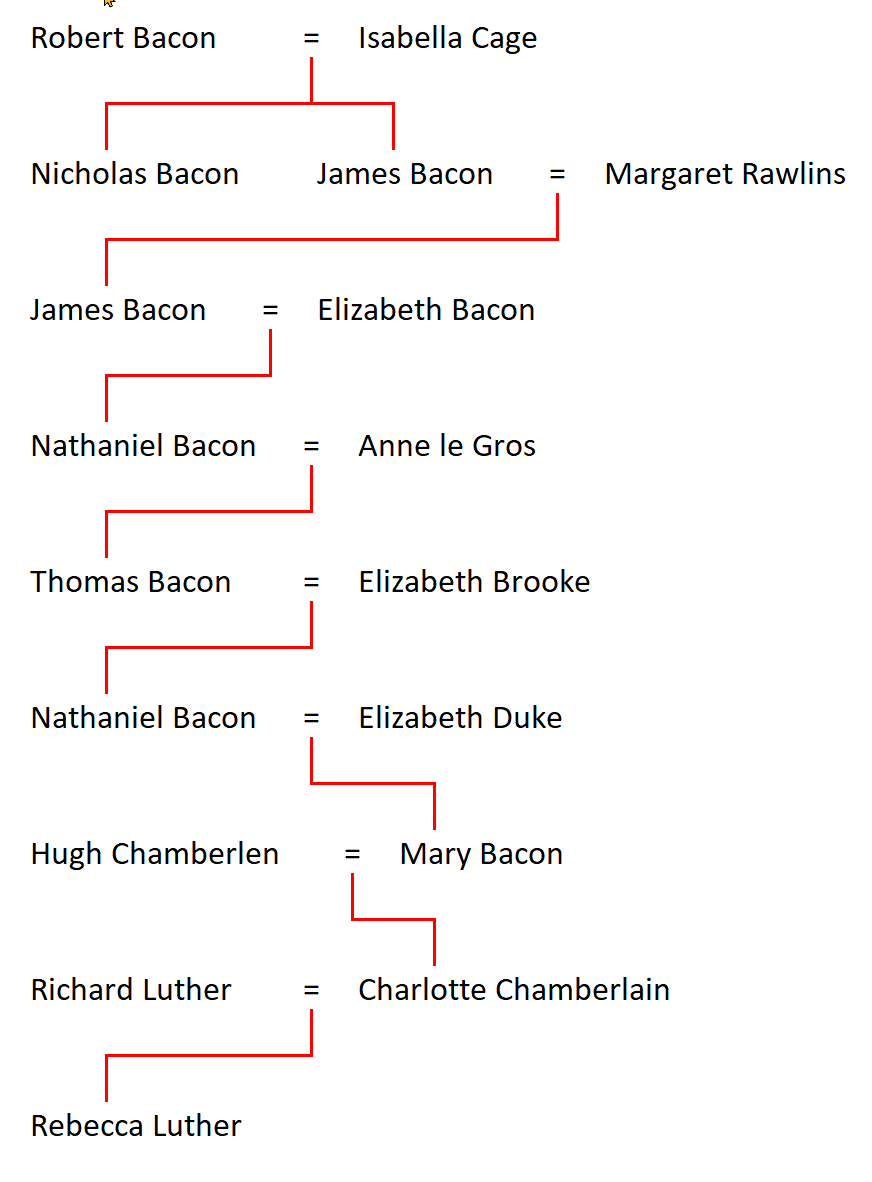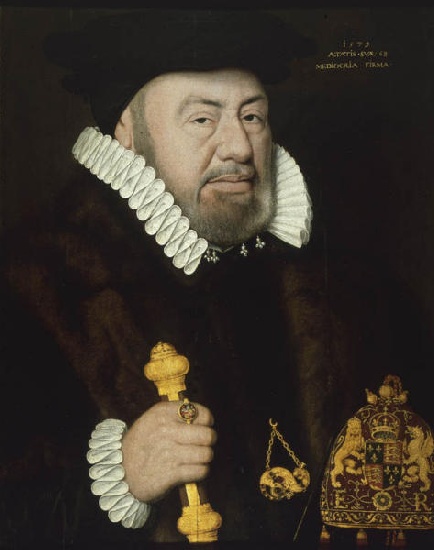Sir Nicholas Bacon, Lord Keeper (Born 1510)
12th Great Granduncle – FFFMFFMMMFFFFU1

Sir Nicholas Bacon, while not a direct ancestor, was very prominent during the reign of Elizabeth I, as he was Lord Keeper of the Great Seal (see “Lord Keeper of the Great Seal” 2024) during the first half of her reign.
He was born at Chislehurst, Kent, the second son of Robert Bacon of Drinkstone, Suffolk by his wife Eleanor (Isabel) Cage, my direct ancestor, James, was the third son who was Alderman and Sheriff of London.
It is thought that Nicholas attended the Abbey school in Bury St. Edmunds. Whether he did or not he was definitely admitted to Corpus Christi College, Cambridge in 1523, and received a BA in 15272. While at Cambridge he made friends with two fellow students William Cecil, afterwads Lord Burghley and Mathhew Parker, afterwards Archbishop of Canterbury3.
After graduation, it is almost certain that he entered an Inn of Chancery before being admitted to Gray’s Inn five years later in 15324. He was called to the bar the following year5.

In 1538 Archbishop Cranmer recommended Nicholas to Thomas Cromwell for the office of town clerk of Calais. He turned it down but on 18 Mar 1540 Nicholas was appointed to the post of solicitor to the Court of Augmentations, a post he held until Jan 1547 when he was appointed attorney to the Court of Wards and Liveries (see “Court of Wards and Liveries” 2025).
Nicholas may well have sat in Parliament in 1539, but most of the members names are missing. However, we do know that he was elected Member for Westmorland in 1542 and Dartford in 1545.
About 1540, he married Jane Ferneley and had by her at least 3 sons and 1 daughter. All three known sons by his first marriage, Nicholas, Nathaniel and Edward became Members of Parliament themselves during the later years of the reign of Elizabeth I.
After the death of his first wife, Nicholas remarried to Anne Cooke a daughter of Sir Anthony Cooke. This cemented his ties with William Cecil who was married to Anne’s older sister Mildred, making Nicholas and Cecil brothers-in-law. Sir Anthony Cooke was tutor to Prince Edward, the future Edward VI.
Nicholas and Anne had a further 2 sons, Anthony and Francis, both of whom became Members of Parliament. Francis was a celebrated philospher6 and was Attorney General and Lord Chancellor under King James I.
He kept a low profile during the reign of Mary and soon after Elizabeth came to the throne he was appointed Lord Keeper of the Great Seal, largely due to the influence of his brother-in-law William Cecil. He was knighted later that same year7.
Almost immediately on his appointment to the office of Lord Keeper, Sir Nicholas helped the other friend he made at Cambridge, Matthew Parker to become Archbishop of Canterbury. Parker was one of the primary architects of the Thirty-nine articles, the defining statement of Anglican doctrine8.
Although he was an implacable enemy of Mary, Queen of Scots, he opposed his brother-ib-law Cecil’s policy of war against France, on financial grounds. In 1559 he was authorized to exercise the full jurisdiction of Lord Chancellor.
Sir Nicholas died on 20 Feb 1579 in London and was buried in Old st Paul’s Cathedral. His grave and monument were destroyed in the Great fire, but a modern monument lists his as one of the important graves lost9. By his will dated 23 Dec 1578 he left £200 towards the building of a new chapel at Corpus Christi College.
References
“BACON, Nicholas (1510-79), of Gray’s Inn and York House, London; Redgrave, Suff. Gorhambury, Herts.” 1964-2020. The History of Parliament Trust. 1964-2020. https://www.historyofparliamentonline.org/volume/1509-1558/member/bacon-nicholas-1510-79.
“Court of Wards and Liveries.” 2025. Wikipedia; Wikimedia Foundation. 2025. https://en.wikipedia.org/w/index.php?title=Court_of_Wards_and_Liveries&oldid=1284972598.
Foster, Joseph. 1889. The Register of Admissions to Gray’s Inn, 1521-1889, Together with the Register of Marriages in Gray’s Inn Chapel, 1695-1754. Vol. 4. London: Hansard Publishing Union Limited. https://hdl.handle.net/2027/coo1.ark:/13960/t0ns1b981.
“Francis Bacon.” 2025. Wikipedia; Wikimedia Foundation. 2025. https://en.wikipedia.org/w/index.php?title=Francis_Bacon&oldid=1288555770.
“Lord Keeper of the Great Seal.” 2024. Wikipedia; Wikimedia Foundation. 2024. https://en.wikipedia.org/w/index.php?title=Lord_Keeper_of_the_Great_Seal&oldid=1211974656.
“Matthew Parker.” 2025. Wikipedia; Wikimedia Foundation. 2025. https://en.wikipedia.org/w/index.php?title=Matthew_Parker&oldid=1285192292.
“Nicholas Bacon (Lord Keeper).” 2025. Wikipedia; Wikimedia Foundation. 2025. https://en.wikipedia.org/w/index.php?title=Nicholas_Bacon_(Lord_Keeper)&oldid=1279955887.
Shaw, WM. A. 1906. The Knights of England. Vol. 2. London: Sherratt; Hughes. https://archive.org/details/knightsofengland02shawuoft/knightsofengland02shawuoft/page/n10/mode/1up.
Stephen, Leslie, ed. 1885. Dictionary of National Biography. Vol. 2. London: MacMillan; Co. https://archive.org/details/dictionaryofnat02stepuoft/mode/1up.
Venn, John. 1922. Alumni Cantabrigienses; a Biographical List of All Known Students, Graduates and Holders of Office at the University of Cambridge, from the Earliest Times to 1900, Part 1. Vol. 1. Cambridge, England: Cambridge University Press. https://archive.org/details/alumnicantabrigipt1vol1univiala/page/n6/mode/1up.
Footnotes
-
When showing relationships F means Father, M means Mother, U means Uncle and A means Aunt. So FFM is my father’s father’s mother, and FFMU is my father’s father’s mother’s uncle.↩
-
(see Stephen 1885), pp. 366-371.↩
-
(see “BACON, Nicholas (1510-79), of Gray’s Inn and York House, London; Redgrave, Suff. Gorhambury, Herts.” 1964-2020).↩
-
(see Foster 1889), p. 298.↩
-
(see “Francis Bacon” 2025).↩
-
(see “Matthew Parker” 2025).↩